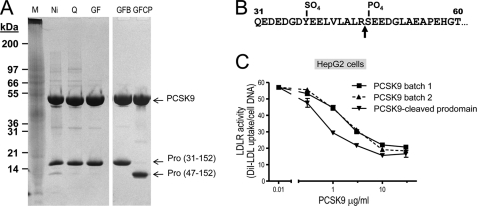FIGURE 1.
Comparative activity of PCSK9 and its shortened prosegment isoform. PCSK9-(His)6 was produced in large quantities from 35-liter baculovirus High Five cells and subjected to multiple steps of purification including Ni2+-affinity followed by Mono Q anion exchange and finally gel filtration chromatography. The anion exchange (SOURCE 15Q) column effectively resolved two forms of PCSK9. The truncated form of PCSK9(47–692) eluted between 100 and 150 mm NaCl, whereas the full-length form of PCSK9(30–692) eluted between 250 and 300 mm NaCl. A, Coomassie Blue staining of 18 μg of total proteins from each preparation separated on a 4–12% gradient in MES buffer, SDS-PAGE under nonreducing conditions are shown. The position of the molecular size markers, total proteins in the High Five supernatant before purification, purification by Ni2+-affinity chromatography (Ni), SOURCE 15Q anion exchange (Q), and Superdex 200 gel filtration (GF) are shown. Notice the presence of a small amount of cleaved prosegment associated with PCSK9 apparent after the nickel purification step, and the two PCSK9 complexes with normal and shorted prosegments were finally resolved and purified to homogeneity after the anion exchange and gel filtration columns in two different preparations (right panels). M, Mark 12 (25 μl); S, supernatant (10 μl); Ni, nickel-nitrilotriacetic acid pool (18 μg); Q, SOURCE Q pool (18 μg); GF, gel filtration pool of batch 7 (18 μg); GFB, gel filtration pool of batch 7B (18 μg); GFCP, gel filtration pool of batch 7CP (18 μg). B, microsequencing analysis of the prosegments revealed an 47SEEDG … sequence demonstrating that the prosegment was cleaved Arg46 (arrow). C, concentration dependence for PCSK9 effect on LDLR of HepG2 cells using diI-LDL incorporation (16). PCSK9(31–692) and PCSK9(47–692) produced and purified from baculovirus/insect cell expression as shown in A were tested for biological activity on the LDLR in the HepG2 cell diI-LDL uptake assay as described under “Experimental Procedures.” Notice that the PCSK9 associated with the truncated 47–152 prosegment is ∼4-fold more active than the WT protein in two independent preparations (batches 1 and 2).

